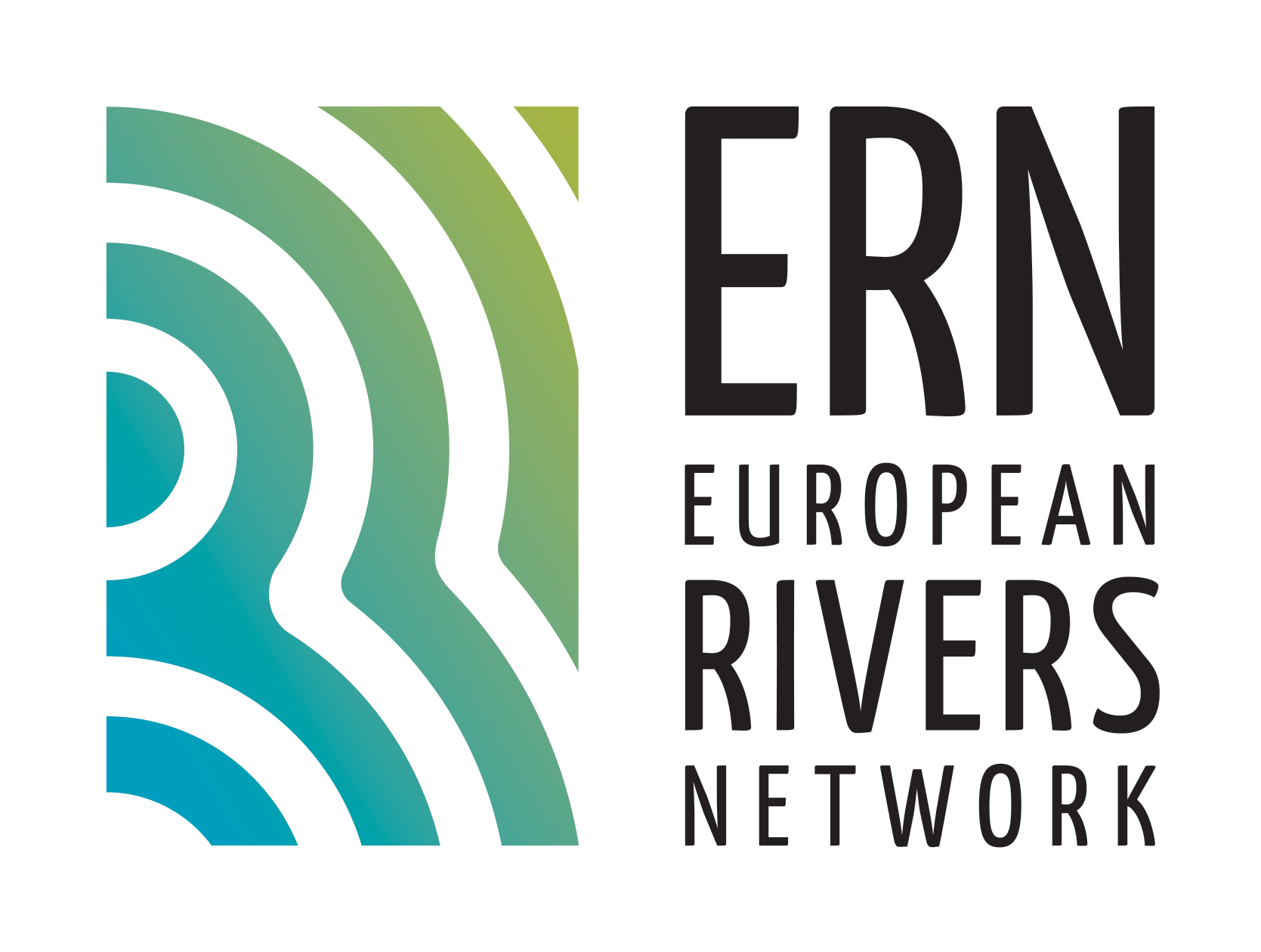Maisons-Rouges Dam Removal
Vienne river (Loire bassin), Indre-et-Loire, France, 1998
The context

Maisons-Rouges dam © Roberto Epple – ERN France
Erected in 1922 as a hydropower concession, about 800 m downstream from the confluence of the Vienne and Creuse rivers, the Maisons-Rouges dam maintains a level difference of about 4 m (downstream of a basin area of about 20,000 km2). Built initially to supply a paper factory, it was integrated into EDF’s assets in 1950. As this dam is the nearest obstacle to the sea, at the confluence of major rivers, its particular situation created a substantial impact on numerous species of migratory fishes. Particularly the salmon, already suffering from reduced access to a part of the spawning grounds, had disappeared. The shads have found shelter in remaining spawning sites downstream of the dam with problems of hybridisation between two species of shads (or aloses) : between the allice shad (alosa) and the twaite shad (alosa fallax/alosa firta).
The different fish-passes had a very low efficiency and the various salmon reintroduction plans undertaken on the Gartempe river (which is one of the Vienne river’s tributaries) had no significant result.
According to the ” Loire Grandeur Nature ” (Natural Loire river plan) which was adopted on January 4, 1994, the Government decided that the dam’s licence would not be renewed at its expiration date of 31st December, 1994 and that the State, becoming the site’s owner at the termination of the concession, should undertake the removal of the work, due to the importance of the impacts which could not be balanced by any sufficient economical interest.
Contracting of Works
The contracting responsibility was the State’s (Ministry for the Environment and territorial planning). The demolition was led by the Indre-et-Loire department of Transport, Urban Planning and Construction Directorate and the actual works were under the responsibility of EDF.
The cost of the operation was about 2,2 million € (1998 :14 million French Francs), mainly financed by the Ministry for the Environment and Territorial planning with the participation of the Loire-Brittany Water Agency.
Particular problems

Removal of the Maisons-Rouges dam © Roberto Epple – ERN France
The main difficulty was due to local opposition as several rural villages would suffer important local tax losses after the dam’s removal. In consequence a complementary plan of economic assistance was set up, at the same level of financial importance as the dam removal cost. Important financial assistance was granted by the State, the water agency, EDF and the Regional/Provincial authorities to support local development operations.
The removal operation was carried out in the summer of 1998, after the technical difficulties had been resolved by the contracting authority. Once half of the site was isolated by cofferdams able to maintain the required water storage for the irrigation of cultivated land, the removal operation essentially consisted in cutting the three sheet-pile curtains with an oxyacetylene cutting flame and pulling down with a mechanical excavator the embankment between these sheet-piles. A drowned sill was made up at the bottom of the river bed, so as to avoid erosion that was foreseeable because of historically extensive sand extraction in the bed of the Vienne and Loire rivers. This also helped to slow down the migration of the sediments found upstream the reservoir.
The sediments consisted of sand and did not raise any problems of quality. Many agricultural pumps which used the reservoir water were restored by the State (this cost being included in the total operation cost). However, a camping site near the confluence about 800 m upstream the dam, did suffer a ground slide and one of the houses shows a few cracks, probably due to a change in the flow of the ground waters resulting from a lowering of the storage water level by 4 m.
Benefits of the removal

Maisons-Rouges, 10 years after removal.
© Roberto Epple – ERN France
The shads very rapidly benefited from the removal of the dam : 433 shads were caught in the river Vienne in Châtellerault, about 20 km upstream of Maisons-Rouges (i.e. 91 from the fish pass and 342 from a fish removal operation ; 156 fish were released upstream of the dam) ; and 15 on the Creuse river downstream of Descartes, about 12 km upstream from Maisons-Rouges.
Active spawning sites were observed on the Vienne river in Châtellerault and on the Creuse river l’Ilette. Lampreys were observed on the Vienne river down-stream of the Châtellerault dam, and consequently a new population of lampreys re-colonised the Creuse river up to Saint-Gaultier, the Gartempe river up to Saulgé and the Anglin up to Cancrenier. The presence in July, 1999 of a living salmon, 88 cm long and weighing 4,8 kg, in the Gartempe river at Châteauponsac in the Haute-Vienne department is a very encouraging sign.
No living salmon had been observed so far upstream since the 1920s, when the Maisons-Rouges dam was built. The symbolic return of the salmon, after that of the shads and lampreys which was observed last winter, confirms the positive effects of the removal of the Maisons-Rouges dam on migratory fishes.
The Chinon University is monitoring this experiment. The first results show that the river bed is dynamically coming back to its initial state.
The 10 year monitoring programme instigated by the Chinon University in 2007 has followed the exceptionally positive increase in migrating fish populations.
Here a few statistics: From 2004 to 2007 an automatic counting station on the Vienne, 20 kilometres above the Maison Rouge, registered 3,500 to 9,500 allis shad, 8,300 to 41,600 sea lamprey, 2-12 brown trout and 2 to 11 adult wild salmon.
Alone in the Creuse in 2007 around 9,000 allis shad, 51,000 sea lamprey, 4 brown trout, 60 salmon were sighted swimming past a camera in Descartes 12 kilometres beyond Maison Rouge.
The demolition of the dam has been an undoubted success. This efficient approach for migratory fish has also shown a huge reduction in the sedimentary deficit in the course of the Vienne, with benefits extending even into the Loire.
Further informations
In French only :
- Poissons migrateurs sur le bassin de la Vienne, Perspectives de développement après effacement du barrage de Maisons Rouges, JF LUQUET, octobre 1993.
- Le franchissement du barrage de Maisons Rouges sur la Vienne par les poissons migrateurs, rapport d’expertise, M. LARINIER et F.TRAVADE, 1993.
- La suppression totale du barrage de Maisons Rouges au Bec-des-Deux-Eaux sur la Vienne : une nécessité pour l’avenir des migrateurs et de la socio-économie des pêches, Dr P. BOISNEAU de l’Association agrée interdépartementale des pêcheurs professionnels du bassin de la Loire et des cours d’eau bretons, mai 1994.
- Expertise du génie civil du barrage de Maisons Rouges, bureau d’étude ISL pour la DDE Indre et Loire, octobre 1996.
- Compte rendu de la réunion qui s’était tenue le 21 novembre 1996 à la préfecture d’Indre et Loire, sur l’avenir du barrage de Maisons Rouges.
- “Résumé non technique “, partie IV de l’étude effectuée par SEPIA Conseils, décembre 1997.
- Restauration des Poissons Migrateurs du Bassin de la Vienne : Objectifs et Investissement, Conseil Supérieur de la Pêche (Cellule Plan Loire), novembre 1996.
- Etude de faisablité et de programmation pour un projet de développement local : Pôle d’Animation sur la Vallée de la Vienne et les Poissons Migrateurs sur la commune de Ports-sur-Vienne, demandée par la Préfecture d’Indre-et-Loire, avril 1999.
- Abondance de la Grande Alose dans la Loire, bilan de différentes études, 1998.
- Revue de presse. - Effacement du barrage de maisons Rouges, synthèse de O. CLERICY et P. BERTEAUD, 1994.
- Etudes des modalités et des implications de l’effacement du barrage de Maisons Rouges, SEPIA-CONSEIL, 1994.
- Etudes des conséquences socio-economiques de l’effacement du barrage de Maisons Rouges, Groupe Cohérences, 1994.

 ERN is the official WWF Freshwater Partner in France and cooperates with WWF Switzerland, Austria, Netherlands and others
ERN is the official WWF Freshwater Partner in France and cooperates with WWF Switzerland, Austria, Netherlands and others